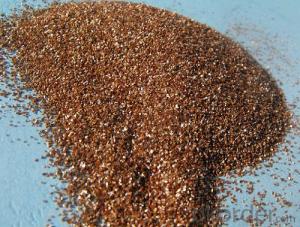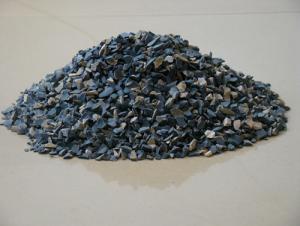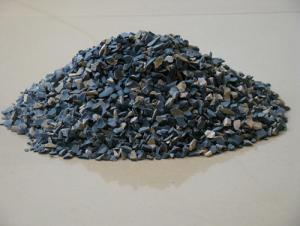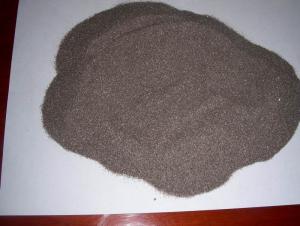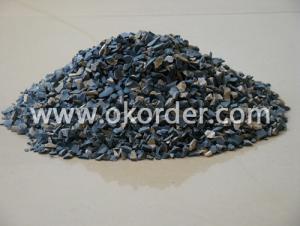Golden Expanded Vermiculite for Refractory Field
- Loading Port:
- Qingdao
- Payment Terms:
- TT OR LC
- Min Order Qty:
- 600 m.t.
- Supply Capability:
- 9000 m.t./month
OKorder Service Pledge
OKorder Financial Service
You Might Also Like
Name | Vermiculite |
Color | Gold |
Size | 0-30um0.3-0.6mm0.65-1mm0.3-1mm0.5-1.5mm0.5-1.2mm 1.2-3.5mm1.5-2.5mm1-2mm2-4mm3-6mm3.5-7mm,4-8mm,etc |
Features | poisonless, odorless , corrosion-resistant, Non-combustible , natural refractory properties , Good thermal insulation , low density ,etc |
They have such advantages as lighter, easy to reduce high-temperature recession heat and cold and corrosion resistant, better ventilation and water preservation , poisonous less and odorless, low hardness, burning-avoidance.
It has already been used in many fields like construction materials ,heat-resistant materials ,sheet materials, painting, rubber, agriculture, forestry, nursery gardening ,forage, cultivation ,pharmacy, friction and sealing, metallurgy, etc.
Basic Information:
1.Fireproof,non-combustible,classA1 non-combustible sheet.
2.Waterproof, moisture-proof, anti-corrosion, acid and alkali resistance.
3.Heat insulation,sound insulation.
4.Low stretching rate,light weight and high strength,overall low density.
5.Smooth surface,can be painted,,paste tile,paste wallpaper and other
decorative materials.
6.Good fire resistance performance,12mm thickness plate can be made
partition ,it can reach 4 hours fire resistance.
7.Construction of low wear and tear, can be cut,saw,nail,bent.
8.Free from smog, poison,smell , erosion,crack , distortion
9.Good safety performance: This product is 100% free of asbestos and
radiation, it will not create the organic substance harmful to human bodies
- Q:What's the maximum temperature that the refractory ceramic fiber cloth can endure?
- Ceramic fiber cloth is high temperature resistant and its continous use temperature can be up to 1000℃. It has high temperature resistance, low heat conductivity, thermal shock resistance, low thermal capacity; superior insulating property at high temperature, long service life; resistance to nonferrous metals like molten aluminum and zinc erosion; low and high temperature strength; innocuity with no adverse effect on the environment; and it is easy to install.
- Q:what should be paid sttention when buying the refractory?
- solve the resources and the cost as much as possible. Accurate understanding and knowing the material temperature changes of various partsin order to choose the appropriate refractories. 4: 3, work performance, for example, take measures to ensure the overall life, and it is a very good buying principles: melting in high temperature metal erosion. These are the four major problems to consider when using refractory. You can choose low prices and low transportation costs of materials to meet the basic principles under the conditions described above. 2.carefully observe the material to prevent the desturction and reducing the costs. according to the structure of furnace, reasonable coordination of all parts of the material, fully take the advantages of material characteristics and strive to develop the recycle, to avoid the destruction of the materials.1. the working characteristics and the sport condition and analyze the reason of destroying the material, which can not only gurantee the product quality and reduce the expenses, get familiar with the chemical component and physics of the material.
- Q:What refractory materials are used in power plant
- Vacuum mud machine, sintering furnace! And then I will introduce some application of thermal material in power plant (below) I hope I can help you. Energy saving is the trend of future industrial development efforts, grinding machine, conveyor belt, so the production of light thermal insulation materials will gain state support, drying kiln. Our factory mainly produce light thermal insulation brick. The refractory material we use most is light insulation brick, and the equipment used is sand mixer (Luohe, Henan)
- Q:What is the criterion of entry of refractory clay industry?
- Standard sizes of refractory bricks in our country are: 230mm × 114mm × 65mm; ordinary brick: 240 * 115 * 53, Building blocks: (blind holes, through-holes) 240 * 390 * 190 * 190,240 * 190,240 * 190,190 * 90 * 190 * 390 * 190,190 * 190,190 * 190,190 * 190 * 90 * 190, 140 * 390 * 190,140 * 190,990 * 190 * 200 * 400, from 0 * 390 * 190 * 190,90 * 190,90 * 90 * 190. There is also an interlocked hollow blocks: 90 * 200 * 200 * 400,90 * 245,90 * 200,90 * 200 * 200 * 100, 90 * 200 * 290,150 * 275,150 * 200 * 200 * 200, 150 * 200 * 100, 150 * 200 * 290.
- Q:What's the feature of construction external wall fireproof and thermal inuslation matertial?
- Building external wall fireproof thermal insulation material is made by stirring, casting, foam protecting and cutting with industrial by-product gypsum as the main raw material, adding sulphate aluminium cement, fly-ash, polymer additives and other materials. It has excellent properties of respiratory function , air permeability, water impermeability, recycling system data, wind load resistance, shock resistance, thermal insulation, fireproof and sound insulation.
- Q:What's the refractory material?
- Frequently used refractory material: AZS brick, corundum brick, direct-bonded?magnesia-chrome?bricks, carborundum brick, silicon nitride bonded silicon carbide brick, nonoxide refractories like nitride, silicide, sulfide, boride and carbide, and oxide refractories like calcium oxide, chromium hemitrioxide, alumina, magnesium oxide and beryllia. In general, the refractory material include the above. For more information, you can ask for specific advice.
- Q:What kind of material is refractory bauxite?
- Bauxite, also known as bauxite alumina or bauxite with high alumina, is the main raw material for the production of high alumina (aluminum content ≥48%, belongs to LAS) refractory. It must be calcined bauxite ore.
- Q:What material is used to make furnace pipe of refractory bricks?
- Refractory brick is called refractory?brick for short. It is a kind of refractory material fired by using refractory clay or other refractory materials. Faint yellow or brownish. It is mainly used in building smelting furnace and has resistance to high temperature 1,580 ℃ -1,770 ℃. Also known as refractory?brick. It is refractory material with a certain shape and size. It can be divided into burnt brick, unburned?brick, fused brick (fused cast brick), fire-resistant insulation brick according to preparation technics; It can be divided into standard brick, ordinary brick and special-shaped brick, etc according to shape and size. It can be used as high-temperature building material and structural material of building kiln and all kinds of thermal equipment. It can also withstand a variety of physical and chemical changes and mechanical action under high temperatures. For example, fireclay brick, high alumina brick, silica?brick, magnesia brick, etc.
- Q:what's the varieties of thermal insulation material with A level fire?rating?
- the main A level fireproof material is rock wool now (note:it is rock wool not mineral wool). A1 level fireproofing, now the largest producer is Taishi rock wool Co., Ltd.; hope my answer can help you, thank you.
- Q:Who knows about the types of Dalian thermal insulating and refractory materials?
- (1) rock wool board: the heat conductivity coefficient is 0.041-0.045. It is fire retardant, has a great temperature absorption while a poor thermal insulation performance. (2) glass wool: it is simple in construction and free in cutting. It has advantages of antibiosis, mould proof, aging resistance and anticorrosion, and can ensure a healthy environment. It has a low hygroscopicity and a stable physical property. (3) expanding polystyrene board(EPS board): thermal conductivity: 0.037-0.041, it has a good thermal insulation performance, cheap price but a poor intensity. (4) extruded polystyrene board(XPS board): thermal conductivity: 0.028-0.03, it has a better thermal insulation performance, high intensity, moisture resistance while it is expensive, and requires surface treatments during construction. (5) gelatine powder polyphenyl granule heat insulating slurry: heat conductivity coefficient: 0.057-0.06, it has a good flame resistance while a poor thermal insulation performance, as well as has high construction requirements and can be recycled. (6) polyurethane foam: heat conductivity coefficient: 0.025-0.028, it has advantages of waterproofness, thermal insulation, high intensity, high integrity, and good integrity, but it has a poor fireproof?performance and is more expensive. (7) rigid polyurethane: heat conductivity coefficient: 0.018-0.023, it has advantages of low heat conductivity coefficient and good thermal performance. When the unit weight of rigid polyurethane is 35 to 40kg per cubic meters, it is equivalent to half of the EPS. It is the one with the lowest heat conductivity coefficient among all the thermal insulation materials. (8) perlite slurry: heat conductivity coefficient: 0.07-0.09, it has advantages of fire and high-temperature resistance, and high water absorption but is poor in thermal insulation.
1. Manufacturer Overview |
|
|---|---|
| Location | |
| Year Established | |
| Annual Output Value | |
| Main Markets | |
| Company Certifications | |
2. Manufacturer Certificates |
|
|---|---|
| a) Certification Name | |
| Range | |
| Reference | |
| Validity Period | |
3. Manufacturer Capability |
|
|---|---|
| a)Trade Capacity | |
| Nearest Port | |
| Export Percentage | |
| No.of Employees in Trade Department | |
| Language Spoken: | |
| b)Factory Information | |
| Factory Size: | |
| No. of Production Lines | |
| Contract Manufacturing | |
| Product Price Range | |
Send your message to us
Golden Expanded Vermiculite for Refractory Field
- Loading Port:
- Qingdao
- Payment Terms:
- TT OR LC
- Min Order Qty:
- 600 m.t.
- Supply Capability:
- 9000 m.t./month
OKorder Service Pledge
OKorder Financial Service
Similar products
New products
Hot products
Related keywords
